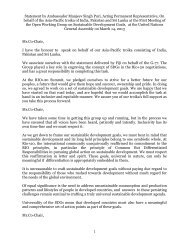STATE OF THE WORLD'S CITIES 2012/2013 Prosperity
STATE OF THE WORLD'S CITIES 2012/2013 Prosperity
STATE OF THE WORLD'S CITIES 2012/2013 Prosperity
Create successful ePaper yourself
Turn your PDF publications into a flip-book with our unique Google optimized e-Paper software.
State of the World’s Cities <strong>2012</strong>/<strong>2013</strong><br />
reflecting a dramatic<br />
There are only<br />
reduction in life expectancy<br />
FACT five cities with<br />
(to 1970s levels). Similar<br />
very weak prosperity<br />
declines are also observed in<br />
factors (CPI below 0.500)<br />
in UN-Habitat’s worldwide<br />
the Democratic Republic of<br />
sample – Bamako,<br />
Congo, Lesotho, Swaziland<br />
Antananarivo, Monrovia, or Zambia.<br />
Niamey and Conakry. Their<br />
It is important to<br />
common feature is that they note that inequality<br />
have recently experienced<br />
further weakens the CPI<br />
various types of conflict<br />
with various degrees of<br />
values for Lagos, Harare<br />
intensity. In each of them, and Lusaka. When the<br />
production, quality of life equity index is included<br />
and infrastructure indicators in the CPI, all three cities<br />
are very low.<br />
move from ‘weak’ to ‘very<br />
weak’ prosperity factors<br />
(below 0.500).<br />
Cities with very weak prosperity factors (CPI<br />
below 0.500): Cities in this bracket feature contrasted<br />
patterns among the sub-indices in the CPI. For some,<br />
the dispersion of index values across the ‘spokes’ reflects<br />
institutional and structural problems. For others, the five<br />
dimensions of prosperity do converge, only at very low<br />
values, a hallmark of dysfunctional systems, institutional<br />
failures, sluggish economic growth as well as widespread<br />
poverty and destitution.<br />
Box 1.1.5<br />
visualizing the 5 dimensions of the CPI<br />
Equity index Quality of life index<br />
1.0<br />
Environmental index<br />
Productivity index<br />
0.5<br />
0<br />
Infrastructure index<br />
Vienna<br />
Mexico City<br />
Johannesburg<br />
The two pentagons represent the five ‘spokes’ of prosperity<br />
as measured in five cities and the extent to which they are<br />
imbalanced /balanced in relation to each other. The radar-shaped<br />
graphs suggest where policy interventions are required. For<br />
instance, Nairobi (to the right) performs well in terms of the<br />
environment and infrastructure, but less so on equity, productivity<br />
and quality of life. In Cairo, the situation is the reverse, as the<br />
24<br />
1.0<br />
0.9<br />
0.8<br />
0.7<br />
0.6<br />
0.5<br />
0.4<br />
0.3<br />
0.2<br />
0.1<br />
0<br />
Figure 1.1.7<br />
Cities with very weak prosperity factors<br />
CPI Index (with �ve dimensions)<br />
CPI Index (with four dimensions)<br />
Infrastructure Development Index<br />
Environmental Sustainability Index<br />
Monrovia<br />
Conakry<br />
Antananarivo<br />
Productivity index<br />
Productivity Index<br />
Quality of Life Index<br />
Equity Index<br />
Bamako<br />
Niamey<br />
Equity index Quality of life index<br />
1.0<br />
Environmental index<br />
0.5<br />
0<br />
Vienna<br />
Cairo<br />
Nairobi<br />
Infrastructure index<br />
environment appears to be the weaker point in an otherwise<br />
well-balanced pattern of prosperity – although at an overall<br />
lower level compared with Vienna. Similar interpretations can be<br />
derived from the pentagon to the left, which compares the relative<br />
performances of revealing the prosperity patterns for the Mexico<br />
and Johannesburg, again against Vienna’s.




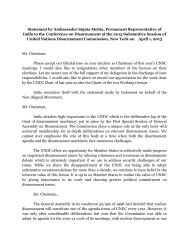
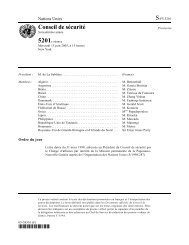
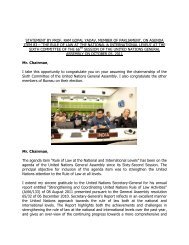
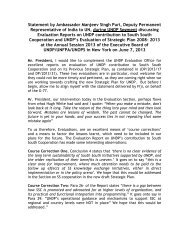
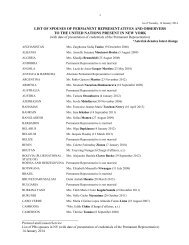
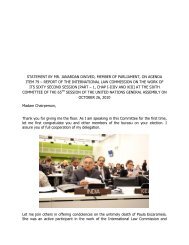
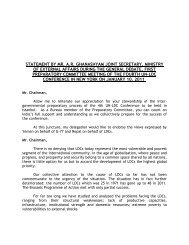
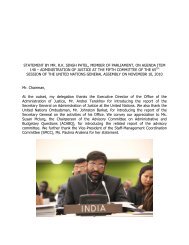

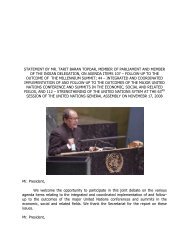
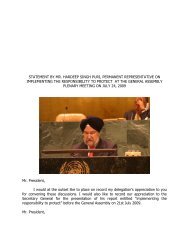
![1 statement by dr.[mrs] kakoli ghosh dastidar - Member States Portal](https://img.yumpu.com/27526598/1/190x245/1-statement-by-drmrs-kakoli-ghosh-dastidar-member-states-portal.jpg?quality=85)
